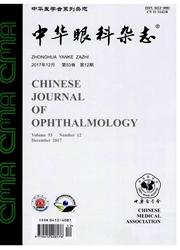

 中文摘要:
中文摘要:
目的进一步分析中国汉族Leber遗传性视神经病变(Leber’s hereditary optic neuropathy,LHON)家系的临床和分子遗传学特征,阐明LHON的分子致病机制。方法对2例具有典型LHON临床特征的先证者和家系其他成员进行眼科学及其临床检查。对这2个家系先证者使用24对有部分重叠的引物进行线粒体DNA(mitochondriat DNA,mtDNA)全序列扩增分析。结果检查发现这些家系成员中视力损害的外显率分别为5.3%(1/19)、18.2%(4/22)。经mtDNA测序分析,并没有发现mtDNAG11778A、G3460A和T14484C3个常见的突变,在tRNAThr。上发现了A15951G同质性突变位点。线粒体DNA全序列分析显示2个家系呈现mtDNA多态性,都属于东亚单倍型D4b1。A15951G突变位于线粒体tRNAThr高度保守区(通用位点为71位),可能导致tRNA空间结构和稳定性发生改变,线粒体蛋白合成功能受损,最终发生视力损害。结论线粒体tRNAThr A15951G可能是与Leber遗传性视神经病变相关的致病性线粒体基因突变。
 英文摘要:
英文摘要:
Objective To explore clinical, genetic and molecular features of two Chinese Han families with Leber' s hereditary optic neuropathy (LHON). Methods Ophthalmologic examinations revealed variable severity and age-at-onset of visual loss among probands and other matrilineal relatives of both families. The families exhibited extremely low penetrance of visual impairment. The entire mitochondrial genome of two probands was amplified by PCR in 24 overlapping fragments using sets of oligonucleotide primers. Results Sequence analysis of complete mitochondrial genorne in the pedigrees excluded three common LHON associated mutations G11778A, G3460A and T14484C, but revealed the presence of a known homoplasmic tRNAThr A15951G mutation. It also showed distinct sets of mtDNA polymorphisms belonging to Eastern Asian haplogroup D4b1. The A15951G mutation is located at the extremely conserved nucleotide (conventional position 71) of tRNAThr. Thus, this mutation may alter the structure and stability of mitochondrial tRNAThr, thereby leading to a failure in the tRNA metabolism and mitochondrial dysfunction, causing visual impairment. Conclusion The results suggested that the A15951G mutation might be involved in the pathogenesis of Leber's hereditary optic neuropathy in the two families.
 同期刊论文项目
同期刊论文项目
 同项目期刊论文
同项目期刊论文
 期刊信息
期刊信息
